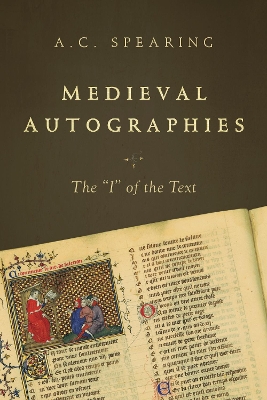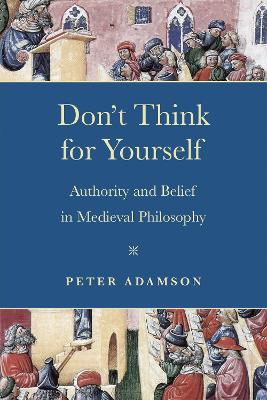Conway Lectures in Medieval Studies
3 total works
In Medieval Autographies, A. C. Spearing develops a new engagement of narrative theory with medieval English first-person writing, focusing on the roles and functions of the "I" as a shifting textual phenomenon, not to be defined either as autobiographical or as the label of a fictional speaker or narrator. Spearing identifies and explores a previously unrecognized category of medieval English poetry, calling it "autography." He describes this form as emerging in the mid-fourteenth century and consisting of extended nonlyrical writings in the first person, embracing prologues, authorial interventions in and commentaries on third-person narratives, and descendants of the dit, a genre of French medieval poetry. He argues that autography arose as a means of liberation from the requirement to tell stories with preordained conclusions and as a way of achieving a closer relation to lived experience, with all its unpredictability and inconsistencies. Autographies, he claims, are marked by a cluster of characteristics including a correspondence to the texture of life as it is experienced, a montage-like unpredictability of structure, and a concern with writing and textuality.
Beginning with what may be the earliest extended first-person narrative in Middle English, Winner and Waster, the book examines instances of the dit as discussed by French scholars, analyzes Chaucer's Wife of Bath's Prologue as a textual performance, and devotes separate chapters to detailed readings of Hoccleve's Regement of Princes prologue, his Complaint and Dialogue, and the witty first-person elements in Osbern Bokenham's legends of saints. An afterword suggests possible further applications of the concept of autography, including discussion of the intermittent autographic commentaries on the narrative in Troilus and Criseyde and Capgrave's Life of Saint Katherine.
How do we judge whether we should be willing to follow the views of experts or whether we ought to try to come to our own, independent views? This book seeks the answer in medieval philosophical thought.
In this engaging study into the history of philosophy and epistemology, Peter Adamson provides an answer to a question as relevant today as it was in the medieval period: how and when should we turn to the authoritative expertise of other people in forming our own beliefs? He challenges us to reconsider our approach to this question through a constructive recovery of the intellectual and cultural traditions of the Islamic world, the Byzantine Empire, and Latin Christendom.
Adamson begins by foregrounding the distinction in Islamic philosophy between taqlīd, or the uncritical acceptance of authority, and ijtihād, or judgment based on independent effort, the latter of which was particularly prized in Islamic law, theology, and philosophy during the medieval period. He then demonstrates how the Islamic tradition paves the way for the development of what he calls a “justified taqlīd,” according to which one develops the skills necessary to critically and selectively follow an authority based on their reliability. The book proceeds to reconfigure our understanding of the relation between authority and independent thought in the medieval world by illuminating how women found spaces to assert their own intellectual authority, how medieval writers evaluated the authoritative status of Plato and Aristotle, and how independent reasoning was deployed to defend one Abrahamic faith against the other. This clear and eloquently written book will interest scholars in and enthusiasts of medieval philosophy, Islamic studies, Byzantine studies, and the history of thought.
Drawing on a wide context of bookmaking, this sweeping study traces fundamental changes in books made to support musical practice during the Carolingian Renaissance.
During the late eighth and ninth centuries, dramatic changes in the way European medieval scribes made books for singers took place, moving from heavy reliance on unwritten knowledge to the introduction of musical notation into manuscripts. Well-made liturgical books were vital to the success of the Carolingian fight for Christian salvation: these were the basis for carrying out worship correctly, rendering it most effective in petitions to the Christian God. In Sounding the Word of God, Susan Rankin explores Carolingian concern with the expression and control of sound in writing-discernible through instructions for readers and singers visible in liturgical books. Her central focus is on books made for singers, including those made for priests. The emergence of musical notations for ecclesiastical chant and of books designed to accommodate those notations, Rankin concludes, are important aspects of the impact of Carolingian reforming zeal on material culture.
The book has three sections. Part 1 considers late antique and early medieval texts, which deal with the value of singing and its necessary regulation. Part 2 describes and investigates techniques used by Carolingian scribes to provide instructions for readers and singers. The extant books themselves are the focus of part 3. Rankin's analysis of over two hundred manuscripts and extensive supporting images represents the work of a scholar who has spent a lifetime with the sources; her explication of the images, particularly those of the earlier manuscripts, changes the way in which musicologists and liturgical scholars will view the images. Indeed, it will change the way in which they approach the unfolding history of chant and liturgy in the Carolingian period.


